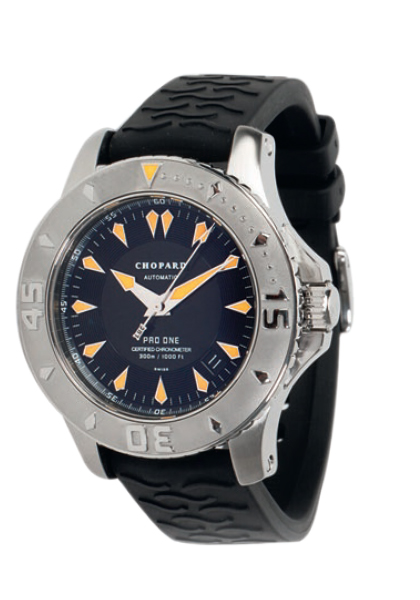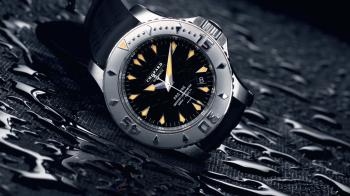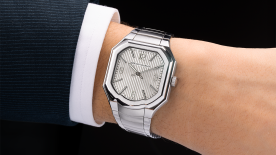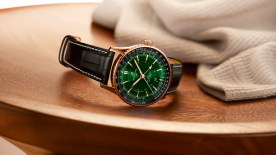Chopard’s L.U.C collection is destined to include only the most sophisticated watches, and sports — of which diving is perhaps one of the most extreme — aren’t a very promising field in that respect. Or at least they weren’t, until the brand dipped a toe into those waters with its Pro One. While the piece definitely had all the trappings of a dive watch, it also managed to feature all the refinements Chopard traditionally provided for this very special collection. For instance, the hour-markers featured a very distinctive design echoing that of the compass rose engraved on the back, with the tip of the hours hand receiving similar treatment. The minutes hand was a slimmed-down version of the Dauphine-type hands that have been a permanent hallmark of the L.U.C style.
Detailing
The centre of the dial featured a stamped, stylised wave pattern, surrounded by the collection’s signature snailed motif. Much of the creative effort focused on the bezel: single-piece, insert-free and made of steel, it was relief-engraved. The latter technique means that rather than cutting into the material to delineate the numbers and hour-markers, Chopard lowered the surrounding metal, leaving the indicators raised above its surface. All the relief elements were polished, while the surface beneath was finely sandblasted to create contrast. The case frame was polished and as such encapsulated L.U.C’s entire style philosophy for this piece: creating a dress dive watch. In the history of sports watches, it was thus quite an early attempt at hybridisation.
Zeitgeist
Chopard gave the piece all the characteristics of a really professional dive watch: a differentiated colour scheme, a screwdown crown complete with crown guard, along with a 300-metre depth rating. The brand went so far as to create a rubber strap with a new motif identical to the one on the dial, as well as a steel bracelet. This creation was not used again, even though such accessories — of which the complexity is always underestimated — often are. With a diameter of 42 millimetres, the L.U.C Pro One was a large-ish watch at the time it was launched in 2002, but soon appeared small compared to the leviathans that were to emerge from beneath the waves in subsequent years.

Reality Check
Like any self-respecting L.U.C, the Pro One sported an in-house movement. At that time, the only available movement base was an ultra-slim calibre with a micro-rotor and a 65-hour power reserve, the 1.96 (now known as the 96.01). Looking back, this might not seem very suitable for a dive watch given this type of movement’s reputation for fragility. That said, a few years previously Chopard had already developed an alternative version of the basic architecture, especially for sports watches. The Sport 2000 model thus served as a design basis for the Pro One. Its 4.96 calibre differed from the baseline model in that it had a rotor made of tungsten (the default material for oscillating weights) as opposed to 22K gold, the material normally used for the L.U.C collection. Besides, while a correlation has gradually been drawn between dive watches and the need for resistance to all kinds of impacts, that doesn’t actually entail causation. Chopard never felt the need to subscribe to this myth, preferring to stick with actual wearing conditions whether underwater or downtown — in other words, relatively benign environments in both cases. Another regular feature (and a must for the brand) was that all the Pro Ones were COSC chronometer-certified.
Developments
The launch version of the Pro One was captivating to say the least, with a black dial accompanied by Super-LumiNova orange hour markers and hands. The solid caseback was engraved with a compass rose. Back in 2002, the L.U.C style was still quite reserved and this colourful version with its lively highlighting marked a real change — a harbinger of many others that were to follow. An alternative version featured white Super-LumiNova, while a third model had a white dial and green Super-LumiNova. The L.U.C style guide gradually evolved, resulting in a new dial layout with the Chopard logo at the centre of a stamped sunray pattern. The Pro One duly complied and in doing so shifted a little more in the direction of elegance with the Pro One GMT. This development made the most of the large bezel, repurposing it in doing so. Previously unidirectional and with 60 minutes graduations, it became bidirectional and acquired the 24-hour indications typical of GMT watches. This was undoubtedly the most accomplished version, leveraging every aspect of L.U.C’s unwaveringly elegant style ethos.
This year GMT Magazine and WorldTempus have embarked on the ambitious project of summarising the divers watch since 2000 in The Millennium Watch Book - Divers watch, a big, beautifully laid out coffee table book. This article is an extract. The Millennium Watch Book - Divers watch is available in both French and English here:







